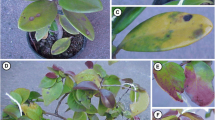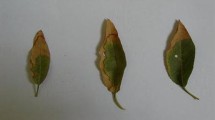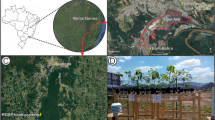Abstract
The gladiolus variety ‘Snow Princess’, which is very susceptible to HF, was used in field experiments to investigate the correlation between traces of HF occurring in the atmosphere and a gradually developing leaf tip injury such as occurs in some gladiolus varieties. The average HF-pollution in the atmosphere could be estimated by using filter papers soaked in lime water. The plants growing in atmospheres polluted with HF showed a gradual increase of leaf tip burn. Leaf tips 15 cm in length were analysed for their fluorine content A positive correlation was found between the average concentration of HF in the atmosphere, the length of leaf tip burn and the fluorine content of the leaf tips.
Samenvatting
Op verschillende plaatsen in Nederland kwam bij bepaalde tuple- en gladiolerassen een geelwitte verkleuring voor, die zich vanuit de bladpunt zeer langzaam uitbreidde. Dat deze rassen zeer gevoelig voor HF zijn, werd aangetoond door middel van kunstmatige begassingen, waarbij dezelfde verkleuringen ontstonden. Om na te gaan of zeer kleine hoeveelheden HF in de atmosfeer tot deze zich geleidelijk ontwikkelende bladbeschadiging aanleiding kunnen geven, werden in bovengenoemde gebieden en op plaatsen waar geen luchtverontreiniging voorkomt proefveldjes aangelegd en beplant met het gladioleras ‘Sneeuwprinses’. Van deze planten werd de lengte van de bladpuntbeschadiging tijdens het groeiseizoen verscheidene keren gemeten. Bovendien werden bladpunten van 15 cm lengte op fluorgehalte geanalyseerd. De bij de proefvelden opgestelde HF-meetapparaten leverden gegevens over de gemiddelde HF-gehalten van de lucht tijdens de teelt op.
Uit dit onderzoek is gebleken dat in gebieden waar de zich zeer geleidelijk ontwikkelde bladverkleuring werd waargenomen, meer fluor in het blad en in de lucht werd gevonden dan op plaatsen waar dit zeer gevoelige gladioleras vrijwel niet beschadigd werd.
Similar content being viewed by others
References
Adams, D. F.,-1961. A quantitative study of the limed filter paper technique for fluorine air pollution studies. Int. J. Air. Pollut. 4: 247–255.
Barkman, J. J.,-1958. On the ecology of Cryptogamic epiphytes with special reference to the Netherlands. Van Gorcum, 's-Gravenhage.
McIntire, W. H.,-1956. Spanish moss and filter paper exposures for detection of air-borne fluorides. J. agric. Fd. Chem. 4: 613–620.
Stern, Arthur C.,-1962. Air Pollution Volume I. Academic Press, New York and London, 1962.
Thomas, M. D., &R. H. Hendricks,-1956. Effect of air pollution on plants, Chapter 9. In:Magill, P. L., F. R. Holden, &C. Ackley, Air Pollution Handbook, McGraw-Hill, New York.
Author information
Authors and Affiliations
Rights and permissions
About this article
Cite this article
Spierings, F.H.F.G. Chronic discoloration of leaf tips of gladiolus and its relation to the hydrogen fluoride content of the air and the fluorine content of the leaves. Netherlands Journal of Plant Pathology 73, 25–28 (1967). https://doi.org/10.1007/BF02023675
Accepted:
Issue Date:
DOI: https://doi.org/10.1007/BF02023675




